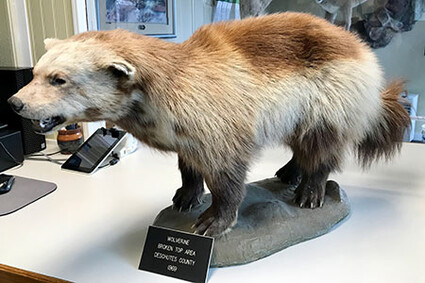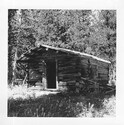The Sheriff and the last wolverine
Last updated 1/17/2023 at Noon
In Sisters we live with a dramatic backdrop of Cascade mountains, close to the wilderness and its mysteries. But one character in the cast of characters of wild places is missing, and people are still out there looking for it. Is the wolverine, a solitary carnivore, gone from our mountains or could it return someday?
A month before he passed away, our beloved friend, naturalist Jim Anderson, suggested a quest was still needed to follow a tale he had been intrigued with for many years.
Jim wrote, “I just happened to be in town the day the old Sisters Marshal, the guy who was also a trapper, came to town carrying the (last?) wolverine he got up on the edge of the wilderness in an old cow camp, Dean & Lily Hollinshead took me on a horse ride there back in the mid-’50s. Fred Painter was his name and he was quite a character.”
So was Jim!
Fred Painter served as the Sisters police chief for many years. He was a municipal one-man band, performing law-enforcement duties, as well as being in charge of the city water system and water bill collection. A veteran trapper, on his day off he liked to relax by heading to the high country with his dog Rusty to check his traplines.
Trapping was once part of the way of life and economy of Sisters. Tillie Wilson and Alice Scott recount trapping history in their book “That Was Yesterday.” Beginning in the 1880s, trappers built cabins along their traplines for shelter in the high country, where they sought pine marten, montane foxes, and bear, which were then prolific. Wilson and Scott report a man named Herb Glazier once brought in 200 pine marten furs from around South Sister.
That day in 1969 when Fred Painter came back to town from Broken Top, it caused quite a stir because everyone said he had caught the last wolverine. In a show of respect, Fred had it stuffed and mounted and presented it to the Oregon Department of Fish and Wildlife office in Bend, where it stood in the front office for many years.
Many find wolverines intriguing. Ochoco National Forest Wildlife Biologist Monty Gregg explained the charisma of these solitary creatures, which resemble a cross between a big dog and small bear. Mostly scavengers, they can also kill with sharp claws and strong teeth.
“I think it’s because of what a hearty critter they are,” he said. “They have no problem summitting a 14,000-foot peak just to see what’s up there. They can travel 60 miles a day scavenging for food. They gain weight in the dead of winter. They are proficient eaters, they don’t waste anything, they consume bones, hide and all, everything but an animal’s teeth.” This could explain their scientific name Gulo. “Gulo” being Latin for ‘glutton.’”
Wolverines use subalpine and alpine forests for foraging and need steep, persistent snow banks for denning, and to store food. They cleverly use snowbanks like a fridge, burying carcasses for later. They have low reproduction and need large areas to forage. Sensitive to people and habitat fragmentation, they have vanished from many areas.
Former Sisters Wildlife Biologist Lauri Turner reviewed reported sightings near Sisters. Size is telling, since wolverines are sometimes confused with smaller marmots or marten. Turner said they are “short, stocky, and dog size, but not as big as a lab.”
Few have seen a wolverine in the wild. From 2012 to 2014, Gregg and Tim Hiller of the Oregon Department of Fish and Wildlife (ODFW) did wolverine surveys in the Central Oregon Cascades. It was grueling, hiking on snowshoes in deep snow to remote areas with heavy packs of frozen roadkill. They set up baited photo stations that also captured traces of hair for DNA analysis. They got photos and hair of pine marten and montane foxes. Ancient rusted traps still sat in some trees, visible during the deep snows of the winter, but six feet off the ground in summer. No wolverine.
However, ODFW Carnivore Biologist Derek Broman had good news: “The wolverine topic may be more alive than people think.”
In a show of collaboration, five western states banded together for broad surveys. Twenty sites were surveyed in Oregon alone. New technology lightens the load by using scent pumps that emit a concoction of odors wolverines find delicious. This allows longer sampling periods and reduces risk to staff hiking to remote areas. There were two new detections, and a video by an observant hunter of a wolverine walking by with an elk leg in its mouth, that Broman termed “just incredible!”
As the glaciers of the Cascades shrink and human activity in the wilderness grows, we may not see a wolverine in Sisters Country again. But a keepsake of our wilder days, Fred Painter’s wolverine, still survives in the ODFW office. After 54 years, he is a bit pale, faded from years of Central Oregon sunlight. But he still looks like the wild child of a dog and a bear. The biologists keep him close now, out of the sun, a guardian in their break room. Was he the last we’ll see? You never know... Keep your eyes open if you are one of those that is drawn to the quiet high country. Maybe you will glimpse this lonely spirit of the wild. Imagine Jim’s delight.























Reader Comments(0)